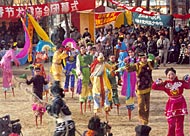 Temple fairs are a Beijing custom that dates back to the Liao Dynasty. In the Yuan Dynasty, the bustling temple fair in Chenghuangmiao (Temple of the City God) Street-present-day Chengfang Street-Became particularly famous. During the Ming Dynasty, temple fairs became widespread, and under the Qing Dynasty their numbers further increased. After the Revolution of 1911, however, large permanent markets were established and temple fairs gradually disappeared.
Temple fairs are a Beijing custom that dates back to the Liao Dynasty. In the Yuan Dynasty, the bustling temple fair in Chenghuangmiao (Temple of the City God) Street-present-day Chengfang Street-Became particularly famous. During the Ming Dynasty, temple fairs became widespread, and under the Qing Dynasty their numbers further increased. After the Revolution of 1911, however, large permanent markets were established and temple fairs gradually disappeared.
Temple fairs were said to have their origins in the ancient ?she sacrifice.? A she was where sacrifices to the local God of Earth were offered. Altars t the Gods of Earth and Grain were also known as Earth Temples. It is from gatherings that took place at these temples that temple fairs derived their name.
In Beijing, temple fairs were held in turn every 10 days at the Earth Temple, the Flower Market, the White Pagoda Temple, the Huguo (Protect the Nation) Temple and the Longfu (Intense Happiness) Temple. There was also the annual Changdian (Factory Grounds) Fair held during the first 15 days of the first lunar month and the annual Pantaogong (Peach of Immortality Palace) Fair held from the third day of the third lunar month inside the Dongbianmen (Eastern Informal) Gate. The fairs mentioned above took place regularly for over 300 years.
The Longfu Mansion, established more than 30 years ago, stands on the site of the old Longfu (Intense Happiness) Temple. The temple, built during the reign of Emperor Jingtai of the Ming Dynasty in 1452, had the largest pair of temple gates in Beijing. The temple was composed of five courtyards, each with a large central hall connected by long galleries. A large part of the temple was destroyed in 1900 when the Eight-power Allied Forces invaded Beijing.
Visitors to the temple fairs included both city folk and peasants from the outlying regions. Customers could buy a variety of locally made products such as ?Gold Elephant Zhang?s? double-edged combs, ?Iron Knife Liu?s? fruit knives and ?Sanheju?wigs, as well as second-hand clothes, jewelry and cloth, bamboo and wicker products, flowers, birds, fish and insects. Nowadays, the Longfu Bazaar, with an area of over 4,700 square meters, is one of the biggest shopping centers in Beijing.
The Changdian Fair was a favorite outing for Beijing residents during the lunar New Year (Spring Festival). Changdian was a small street with only 10 or so houses, but each year at the Spring Festival it, along with the adjacent Liulicahng Street, Xinhua Road, the Lu Dongbin Hall (Luzudian), the Jade Emperor Pavilion and the Shatu (Sandy Soil) Gardens, became a large market. In pre-Ming times, this area was a tiny village in a sparsely populated tract of countryside known since the Liao Dynasty as the Village of the King of the Sea. By the time of Emperor Jiajing (reigned 1521-1566), this area had already begun to grow. Chosen in 1553 for the imperial Glazed Tile Works, its name became Liulichang Changdian (Glazed Tile Works Grounds). In the Qing Dynasty, the tile works was moved to a site near the Western Hills, but the streets named Liulichang and Changdian remained and the area developed into a public market.
The Changdian Fair, held in the first lunar month, drew people from all parts of the city to buy and sell paintings and calligraphic works, antiques, articles for daily use, children?s toys, food products and seasonal fruit and vegetables. In addition, entertainment was provided in the form of acrobatics, conjuring and operas.
After the founding of the Republic of China in 1912, trade in antiques at the Changdian Fair increased markedly. With the downfall of the Qing, former residents of the Imperial Palace, as well as princes, nobles and the descendants of deposed officials whose wealth and position were declining came to sell off their treasures. They found keen buyers among the emerging class of wealthy warlords, bureaucrats and politicians who were eager to pose as lovers of culture. Many foreigners also showed great interest in Chinese antiques.
According to rough statistics available on the 1931 Spring Festival Fair at Changdian, of a total of about 1,000 stalls, some 300 dealt in antiques and jade, over 200 in toys and novelties and over 100 in food products. In addition, there were over 100 stalls selling daily necessities and 200 that sold miscellaneous goods. Businessmen from overseas also realized the potential of the Changdian Fair as a market for their products. By 1935, of the 100 stalls at the fair dealing in toys and novelties, 80 were selling Japanese goods.
After 1949, the Changdian Fair continued to operate each year at Spring Festival. The 1963 fair were the largest since the founding of the People?s Republic of China with over 750 stalls attracting over 4 million visitors.












